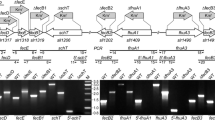Abstract
A Tn5-1063-derived mutant of Nostoc punctiforme strain ATCC 29133 was unable to fix N2 in air although it reduced acetylene in the absence of O2. Mutant strain UCD 307 formed cells morphologically similar to heterocysts, but it failed to synthesize the characteristic heterocyst glycolipids. Sequence analysis around the site of insertion revealed an ORF of 3,159 base pairs, termed hglE. hglE putatively encodes a 115.4-kDa protein containing two domains with conserved amino acid sequences identified with acyl transferase and the chain length factor variation of β-ketoacyl synthase active sites. These active sites are characteristic of polyketide and fatty acid synthases. The N. punctiforme strain 29133 hglE gene is transcribed only under nitrogen-limiting growth conditions. The hglE gene, or similar sequences, was found in all other heterocyst-forming cyanobacteria surveyed and was absent in unicellular Synechococcus sp. strain PCC 7942. Based on these results, we propose that the synthesis of heterocyst glycolipids follows a pathway characteristic of polyketide synthesis and involves similar large, multienzyme complexes.
Similar content being viewed by others
Author information
Authors and Affiliations
Additional information
Received: 4 November 1996 / Accepted: 6 January 1997
Rights and permissions
About this article
Cite this article
Campbell, E., Cohen, M. & Meeks, J. A polyketide-synthase-like gene is involved in the synthesis of heterocyst glycolipids in Nostoc punctiforme strain ATCC 29133. Arch Microbiol 167, 251–258 (1997). https://doi.org/10.1007/s002030050440
Published:
Issue Date:
DOI: https://doi.org/10.1007/s002030050440




